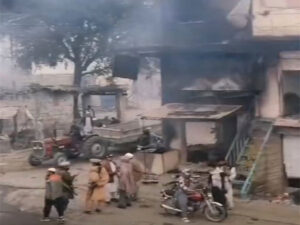
Islamabad [Pakistan], October 3 (ANI): The United Nations has revised its humanitarian appeal for Pakistan five-fold to USD 816 million from USD 160 million as it seeks to control a rise in water-borne diseases after an unprecedented flood situation in the country that has claimed over 1700 lives. “We are now entering a second wave of death and destruction,” Julien Harneis, UN Humanitarian Coordinator for Pakistan said at a Geneva briefing. Harneis was quoted as saying by Pakistan’s Dawn newspaper. “There will be an increase in child morbidity and it will be pretty terrible unless we act rapidly to support the government in increasing the provision of health, nutrition and water and sanitation services across the affected areas,” he said.
In a press statement, Pakistan’s foreign ministry said an up-scaled Flash Appeal is being jointly launched by the Government of Pakistan and the United Nations (UN) on October 4 in Geneva. The Pakistan government said this revision has been made on the basis of an updated on-ground needs assessment of the flood situation in the country. “Ministerial level participation from the Government of Pakistan will include Minister for Climate Change Senator Sherry Rehman, attending the event in person in Geneva, and Minister for Planning, Development and Special Initiatives Professor Ahsan Iqbal, Minister for Economic Affairs Sardar Ayaz Sadiq, and Minister of State for Foreign Affairs Hina Rabbani Khar participating virtually from Islamabad,” the foreign ministry said.
UN Under-Secretary-General for Humanitarian Affairs and Emergency Relief Coordinator Martin Griffiths and Director General World Health Organization Dr Tedros Adhanom Ghebreyesus will represent the UN, along with Resident Coordinator in Pakistan Julien Harneis.
The meeting will be attended by the UN Member States as well as various UN agencies and humanitarian organizations working in disaster relief. The Floods Response Plan has been prepared in close coordination between the Government of Pakistan and the United Nations and focuses on providing necessary assistance to the vulnerable people affected by the unprecedented floods. It complements the Government’s overall response to the recent climate-induced floods in Pakistan.
As of September 30, the National Disaster Management Authority (NDMA) has recorded nearly 1,700 deaths and more than 12,800 injuries since mid-June. The highest death rates were recorded in Sindh (747), Balochistan (325) and Khyber Pakhtunkhwa (307). More than 2 million houses have been damaged or destroyed and around 7.9 million people are reportedly displaced, including some 598,000 people living in relief camps, according to reports by the Provincial Disaster Management Authorities (PDMA) of the affected provinces.
Estimates indicate that more than 7,000 schools are currently being used to host displaced populations, while an estimated 25,100 schools have been damaged. (ANI)
Pakistan farmers stuck in vicious cycle of debt as crops destroyed in floods
As floodwaters in Pakistan recede, the story of those in the worst affected regions comes to the surface with many farmers sharing their woes of being stuck in a vicious cycle of sinking into debt and not being able to pay back the landlords, media reports said.
Farmers are left with no choice but to stay in the same circumstance. While speaking to the New York Times, Mairaj Meghwar, a farmer in his 40s who lives in the village of Lal Muhammad in Sindh Province, said, “Our life goes like that — sinking into debt, not earning the money to pay it back, and then we do it again.”
Sindh is among those provinces that have sustained the most flood damage. Around 40 families live in the Lal Muhammad village. Due to the floods, the houses have been brought to rubble and a huge loss has been inflicted on livestock.
The path connecting to the nearest town is an hour’s drive by motorcycle away. Describing the situation around, the media outlet reported that the snakes were gliding past people and swarms of mosquitoes whirred in her ears.
This happens as the dengue outbreak worsens in Pakistan. Farmworker Barmeena only 14 years of age had no choice. “It was our only source of livelihood,” she said to visiting New York Times journalists. Her fields were completely destroyed in the deadly floods. On the other hand, the authorities have warned that the floodwater may not fully recede for months. However, in places where the floods waters have receded, the farmers, in a desperate attempt, are scrambling to salvage whatever they can from the battered remains of their cotton and rice harvests, reported New York Post.
As Pakistan’s flood fury wreaks havoc in different provinces, farmers are finding themselves in another trouble as they are already buried under the debt they owe to landlords. Many already owe hundreds or thousands of dollars to the landlords whose fields they cultivate each year, as part of a system that has long governed much of rural Pakistan.
The landlords each planting season offer farmers loans so that they can buy fertilizers and seeds. With the purchased items they cultivate their fields which earns them a meagre amount. A small cut of the harvest goes toward repaying the loan.
The farmers are making desperate attempts to sail through the troubled waters. And now, their summer harvests are in ruins. Unless the water recedes, they will not be able to plant the wheat they harvest each spring. Even if they can, the land is certain to produce less after being damaged by the floodwaters, from a cataclysmic combination of heavy glacier melt and record monsoon rains, which scientists say were both intensified by climate change, reported New York Post. (ANI)



















